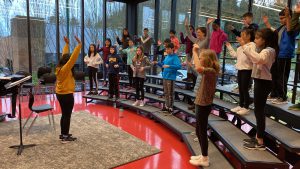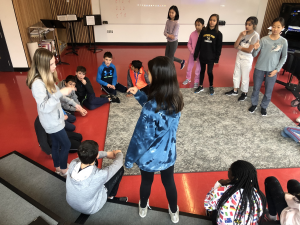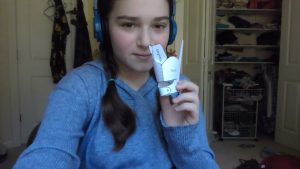(1) begins class sessions with a clear statement about the lesson’s objectives and place in the progression of course
(2) designs and implements varied activities in each class period
(3) brings each activity to closure effectively and transitions intentionally to subsequent activities
(4) ensures that students are using technology and tools effectively
(5) concludes class with a summary and clear tie-in to the next class
Many indicators defined in Pedagogical Effectiveness support the tenet that a strong routine is sound pedagogy. Just like a piece of writing, classes need an introduction, a structure in which to operate, and a conclusion identifying something relevant to the reader, or next steps in achieving a larger learning goal. In choir, as we work toward a shared goal of the concert, the daily routine of class is designed to develop skill, learn content, and reflect on our process. In the new landscape of remote teaching, how we do this has changed but the essential questions of the course have not. In all choir classes, we establish the concert as our common goal; the project we work toward that gives context and purpose for our daily learning. Working backwards from the end goal of the concert, the daily learning is structured in 85 minute periods that have dedicated time to answer the essential questions of the class: how do I use my voice as an instrument (skills built through warm ups)? How do I develop the aural and visual skills to read music notation (skills built through games and other activities)? How do I perform in an ensemble (skills built through rehearsal)?
From day one we work to establish our daily routine. We always start with warm ups (Ped-7), learning how to use the voice as an instrument through intentional work that is often disguised as play.  During the opening physical warm up while preparing the body to sing, I often give verbal announcements including a reminder of the concert count down (1) (Ped-4). This allows the students to understand where we are in the calendar of the trimester and also serves as a management tool to remind them that although we have fun in class, we have to stay focused to put on a successful concert (Ped-2).
During the opening physical warm up while preparing the body to sing, I often give verbal announcements including a reminder of the concert count down (1) (Ped-4). This allows the students to understand where we are in the calendar of the trimester and also serves as a management tool to remind them that although we have fun in class, we have to stay focused to put on a successful concert (Ped-2).
After warming up, we typically transition to a musicianship activity that develops auditory or notation skills. Again, this can take the form of a game (Ped-13).  Musicianship skill building as well as warm-ups are a fantastic opportunity to draw on concert material as a source, providing students with early and repeated exposure to material that they will be asked to recreate during rehearsal. After musicianship building we transition to rehearsal, which is one large feedback loop, or, a beautiful example of formative assessment in action. The conductor responds to what she hears and coaches the student musicians towards their goal by drawing from a developmentally appropriate toolbox of rehearsal methods (Ped-12).
Musicianship skill building as well as warm-ups are a fantastic opportunity to draw on concert material as a source, providing students with early and repeated exposure to material that they will be asked to recreate during rehearsal. After musicianship building we transition to rehearsal, which is one large feedback loop, or, a beautiful example of formative assessment in action. The conductor responds to what she hears and coaches the student musicians towards their goal by drawing from a developmentally appropriate toolbox of rehearsal methods (Ped-12).
Transitions are another art form in all teaching professions, a tenet of strong pedagogy or an opportunity for everything to fall apart as students lose focus. In my classes, we typically transition using reflection. The students, after standing during active rehearsal, may sit for a moment as we reflect (3,5) – what was our goal for that part of rehearsal? Did we achieve it? How, or why not? How did it physical feel? What did you hear? What will we do differently next time? What will we try to recreate? This process is at the heart of rehearsing music (Ped-5). Those same questions can be used to reflect on a very specific goal in rehearsal, or the concert itself. Eventually, in the most rewarding of circumstances, students are able to lead this part by themselves, demonstrating ownership of the artistic decision making and rehearsal process.
Within this strong routine, class activities are designed to take advantage of the many modes by which music can be accessed. By leveraging the multi-dimensional nature of music, a class can be designed to embrace a variety of learning methods (2). In the section on Differentiated Instruction, I describe in detail how one musical concept of syncopation is explored through movement, listening, symbol analysis, and finally the act of doing. A class can be designed that includes a kinesthetic exploration of sound, critical listening and studying the artistic choices of others, an analysis of notation, and the act of performing for others. I find joy in taking advantage of this quality of music and designing contrasting methods to explore a narrow topic, while simultaneously preparing for the concert.
Regarding technology, the culture of the in-person classroom is such that the students do not use computers unless they are specifically directed to do so. However, in our new mode of EPSRemote, this has obviously shifted (4). Teaching online has required me to think big picture about my teaching goals. The essential questions remain, but as the horizon for resuming in-person class remains in the distant future, how I have answered these questions has shifted and I expect will continue to do so.
In this new mode, it is possible to pursue most of our goals. To learn how to use the voice as an instrument, we studied the anatomy and physiology of the voice. This is always a part of class, but in the online classes it had a larger role to play than usual.
We watched videos of vocalists being scoped, (see above) and built a paper model of the larynx. We warm up the body and breath daily, and sing a little (sadly, on mute due to latency). To develop and maintain our musicianship skills, lessons online are offered more through direct instruction than in the classroom where we can play games.  In the upper school, individual skill development is practice and tracked through Sightreading Factory (Ped-14) and Musictheory.net. The ensemble rehearsal piece is replaced with individual and small group project-based learning. Due to latency, it is not possible to rehearse online so instead the students use Sound Trap, an online digital audio workstation, to record themselves and collaborate with their peers. Middle school projects this term include making a three-part round with yourself, exploring how high and low your voice can go, learning about production effects used on the voice through a karaoke recording challenge, and writing and recording a PSA parody.
In the upper school, individual skill development is practice and tracked through Sightreading Factory (Ped-14) and Musictheory.net. The ensemble rehearsal piece is replaced with individual and small group project-based learning. Due to latency, it is not possible to rehearse online so instead the students use Sound Trap, an online digital audio workstation, to record themselves and collaborate with their peers. Middle school projects this term include making a three-part round with yourself, exploring how high and low your voice can go, learning about production effects used on the voice through a karaoke recording challenge, and writing and recording a PSA parody.
They learned about rhythm notation through making beats and explored musical form through creating their own song with pre-loaded samples. The more advanced students focused on weekly group projects in a fun class competition, skill building and solo repertoire. If we are to continue remote learning, I would like to develop a practice journal for the students to reflect more on their work and show evidence of progress.
The shifting landscape of teaching online has been an interesting lens through which to consider pedagogical practice. My sense at this time is that the benefits offered through this mode are primarily to students who are more motivated in individual work than ensemble performance. The heart-breaking reality for students who are motivated by the social-emotional benefits of being in an ensemble is that we are still searching for how to reproduce that connection online. The whole professional world of ensemble music is frantically scrambling right now to find a substitute that is safe. At the heart and soul of ensemble music making is the feedback loop of a rehearsal and building community. How can we do that online? While we don’t yet know, maybe it is time for our art form to innovate. Music making is inherent to the human experience; it certainly will never go away, although it may look very different for a few years.